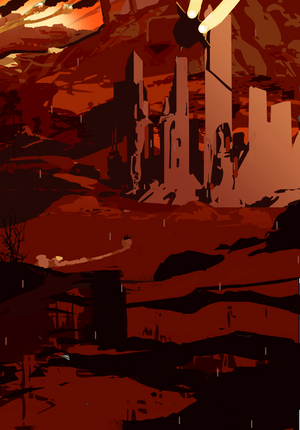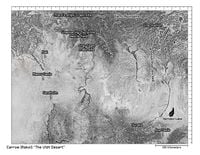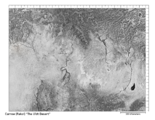Carrow: Difference between revisions
From Halopedia, the Halo wiki
(→Sources: temporary till we get something more proper in place) |
|||
| Line 26: | Line 26: | ||
==History== | ==History== | ||
===Forerunner Usage=== | |||
On Carrow, the [[Forerunner]]s placed on of their [[Sharquoi]] hives, containing hundreds of thousands of the creatures. The hive was buried deep underground and could only be opened using the ''[[vertex]]'', a control device for the Sharquoi hidden at [[Installation 00]]. | |||
===Settlement=== | ===Settlement=== | ||
Carrow was originally much lusher and greener than it is now, but some sort of ecological disaster at an unspecified time caused rivers to dry up. Carrow was originally established as an [[outer colony]] of the [[Unified Earth Government]]. Its capital was [[Suraka]], a city which began small in an oasis but which grew larger. At some point during the war with the Covenant, Carrow emptied of colonists. In the wake of the [[Great Schism]], [[Rojka 'Kaasan]], a [[Sangheili]], assembled a fleet and fled to Carrow in order to establish a new home. The result was [[Rak]], a city built up along the banks of a hidden river in the desert. The [[Unified Earth Government]] permitted the settlement and also facilitated the reclamation of Suraka by new human colonists. Carrow was deemed to belong to a [[Joint-Occupation Zone]]. Not long after, a creaky old human ship bearing fiercely independent migrant refugees of the [[Human-Covenant War]] set its sights on Carrow, and specifically the region where Rak had been established, since it was known from old records there was a river giving life to the desert there. Upon discovering the territory was already occupied by the Sangheili, and without any hope of getting their ship in the air again, the migrants endeavored to carve out a harsh life one-hundred and forty miles from Rak and called their new settlement [[Sandholm]]. | Carrow was originally much lusher and greener than it is now, but some sort of ecological disaster at an unspecified time caused rivers to dry up. Carrow was originally established as an [[outer colony]] of the [[Unified Earth Government]]. Its capital was [[Suraka]], a city which began small in an oasis but which grew larger. At some point during the war with the Covenant, Carrow emptied of colonists. In the wake of the [[Great Schism]], [[Rojka 'Kaasan]], a [[Sangheili]], assembled a fleet and fled to Carrow in order to establish a new home. The result was [[Rak]], a city built up along the banks of a hidden river in the desert. The [[Unified Earth Government]] permitted the settlement and also facilitated the reclamation of Suraka by new human colonists. Carrow was deemed to belong to a [[Joint-Occupation Zone]]. Not long after, a creaky old human ship bearing fiercely independent migrant refugees of the [[Human-Covenant War]] set its sights on Carrow, and specifically the region where Rak had been established, since it was known from old records there was a river giving life to the desert there. Upon discovering the territory was already occupied by the Sangheili, and without any hope of getting their ship in the air again, the migrants endeavored to carve out a harsh life one-hundred and forty miles from Rak and called their new settlement [[Sandholm]]. | ||
=== | ===A New Danger=== | ||
In early [[2558]] the government in [[Rak]] experienced a change in leadership. | In early [[2558]] the government in [[Rak]] experienced a change in leadership. | ||
{{Expand-Section}} | {{Expand-Section}} | ||
Revision as of 14:00, January 7, 2019
| Carrow | |
|---|---|

| |
| Astrographical | |
|
Moon(s): |
One; Kiriken |
| Societal | |
|
Species: |
|
|
Government: |
|
Carrow, referred to by the Sangheili as Rakoi,[2] is a planet in a Joint-Occupation Zone; the home of both humans and Sangheili.
History
Forerunner Usage
On Carrow, the Forerunners placed on of their Sharquoi hives, containing hundreds of thousands of the creatures. The hive was buried deep underground and could only be opened using the vertex, a control device for the Sharquoi hidden at Installation 00.
Settlement
Carrow was originally much lusher and greener than it is now, but some sort of ecological disaster at an unspecified time caused rivers to dry up. Carrow was originally established as an outer colony of the Unified Earth Government. Its capital was Suraka, a city which began small in an oasis but which grew larger. At some point during the war with the Covenant, Carrow emptied of colonists. In the wake of the Great Schism, Rojka 'Kaasan, a Sangheili, assembled a fleet and fled to Carrow in order to establish a new home. The result was Rak, a city built up along the banks of a hidden river in the desert. The Unified Earth Government permitted the settlement and also facilitated the reclamation of Suraka by new human colonists. Carrow was deemed to belong to a Joint-Occupation Zone. Not long after, a creaky old human ship bearing fiercely independent migrant refugees of the Human-Covenant War set its sights on Carrow, and specifically the region where Rak had been established, since it was known from old records there was a river giving life to the desert there. Upon discovering the territory was already occupied by the Sangheili, and without any hope of getting their ship in the air again, the migrants endeavored to carve out a harsh life one-hundred and forty miles from Rak and called their new settlement Sandholm.
A New Danger
In early 2558 the government in Rak experienced a change in leadership. Template:Expand-Section
Geography

Carrow has one main landmass that comprises the majority of its surface. This continent boasts two primary centers of residence: Suraka and Rak, the centers of human and Sangheili governence on the planet, respectively. Between them stretches kilometers of desert. Rak is situated along a hidden river in the midst of this desert. One-hundred and forty kilometers from Rak lies Sandholm, a human settlement. Between them, at seventy kilometers from each, an oasis called Masov Oasis is controlled by Sangheili.
Gallery
List of appearances
- Halo: Fractures
- Oasis (First appearance)
- Halo: Envoy
Sources
- ^ Halo: Fractures, Oasis
- ^ Halo: Envoy Carrow map
